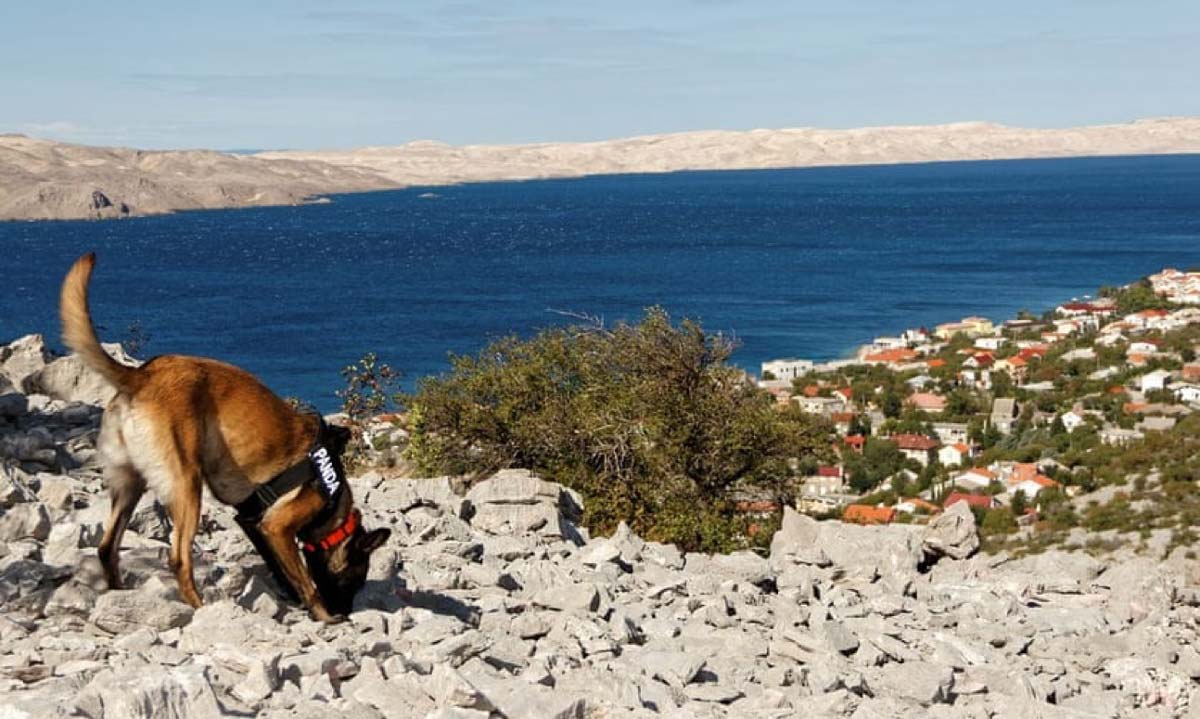Lara Crufts Sniff Out Ancient Tombs In Croatia
Trained sniffer dogs used to locate 3,000-year-old Iron Age burial tombs in Croatia.
A dog's sense of smell, according to an article on Science Net Links, is up to 100,000 times as strong as a person’s, and while human’s have fewer than 400 genes for coding for smell receptors dogs have almost 1,000, not to mention between 125-300 million olfactory receptors compared to our six million. And this is the reason why the scent-tracking abilities of trained dogs have helped archaeologists uncover burial chests containing human bones and artifacts in a hilltop fort in the Velebit Mountains along the Adriatic coast dating back nearly 3,000 years.
Vedrana Glavaš is an associate professor of archaeology at the University of Zadar in Croatia and the lead author of a new study published in the Journal of Archaeological Method and Theory and she thinks dogs are a good way of identifying archaeological sites as they are less destructive than many traditional methods, and what’s more, their noses don’t make as many mistakes as human detection methods do.
Dogs Pass the Double Blind Test
By 2015 Glavaš had a discovered a series of 8th century BC tombs in the necropolis near the prehistoric hilltop fort of Drvišica, and hoping to find more, she employed the services of Andrea Pintar, a dog trainer who specializes in canines used to smell out bodies during criminal investigations.
Belgian Malinois and German Shepherds were let loose at the remote ancient burial site to locate previous graves and a second trainer and dog then searched the sites, not knowing where the first dog and trainer had indicated graves. Even though the search areas had been exposed to wind, sun, and rain and all human remains and artifacts had been removed, the dogs successfully identified all three graves.
Ground Penetrating Nebs
The dogs were then set loose at sites where it was suspected more burials might be found and “six new tombs” consisting of small stone burial chests centered within walled stone circles, measuring about 16.4 feet (5 meters) in diameter each, were discovered. The graves held buckles and other clothing artifacts and the chests contained finger and feet bones of several individuals that might represent several generations of one family.

Bronze buttons discovered during an excavation site discovered by dogs. (Zlatko Bala/Department of Archaeology/University of Zadar)
The biggest question in all this is perhaps, how on earth can a dog, even with a super-smelling ability locate 3,000 year old tombs? Do we still smell that long after dying? According to a report in The Guardian, Glavaš said the rocks were porous and may hold residual scents and another canine expert suggested the dogs could still detect the aroma of decomposition.
- Not Always A Man’s Best Friend: Terrifying Black Dogs of British Legends
- Dogs and Foxes Were Domesticated By Bronze Age Humans
- Viking Dogs Followed Their Masters to Valhalla

One expert said it was likely the dogs could still detect the aroma of decomposition. (Zlatko Bala/Department of Archaeology/University of Zadar)
Angela Perri, a postdoctoral archaeology researcher at Durham University, said adopting dogs to detect burials was an “especially promising technique” where their non-destructive qualities could be utilized in archaeological situations where ground-penetrating radar might be dangerous.
War Dogs And Steel Toothed Cops
Today, we train astronaut dogs in space programs and teach search and rescue dogs to leap from helicopters and speedboats, while medical dogs can detect cancer and smell when a diabetic patient is hypoglycemic (suffering from low blood sugar). But did you know that in July 1943, during WW2, the American Army launched the War Dog training program which saw puppies parachuting into war-zones sniffing out enemy tunnels and bunkers?

U.S. Marines and their dogs, used for scouting and running messages in WWII. (Marion Doss / CC BY-SA 2.0)
And if this is not bizarre enough, visually, then what about a 2001 a report in The Telegraph that told the story of police and army dogs being fitted with razor-sharp titanium fangs costing between $600-$2,000 per tooth.
Canine Chemists
Now, ‘Indiana Dogs’ are searching for, and finding, ancient burial sites and lost tombs in Croatia, but this is not the only country using dogs to assist archaeological efforts. At the beginning of September I wrote an Ancient Origins news piece about another group of ‘Lara Crufts’ who guard Huaca Pucllana, a vast pre-Incan pyramid located in the Miraflores district of central Lima, Peru, built by the Lima Culture around 500 AD.
Archaeologist, Mirella Ganoza, explained in a BBC news article that the Peruvian government declared that the “perro peruano sin pelo”, with its shiny black leathery wrinkled skin, was “an important part of the country's cultural heritage” and today one of these hairless dogs, by law, lives at every archaeological museum site along the Peruvian coast.

Peruvian hairless dog. (Astrostudy / CC BY-SA 3.0)
It should be added that while dogs make great tools of detection and fantastic guards at archaeological sites, they are as of yet banned from scientific ‘labs’, because it seems that when archaeologists bring in bones for chemical testing the canine chemists just seem to lose it and ‘barium’.
Top image: The archaeology dogs proved extremely accurate in pinpointing the tombs. Source: Zlatko Bala/Department of Archaeology/University of Zadar.
By Ashley Cowie



















